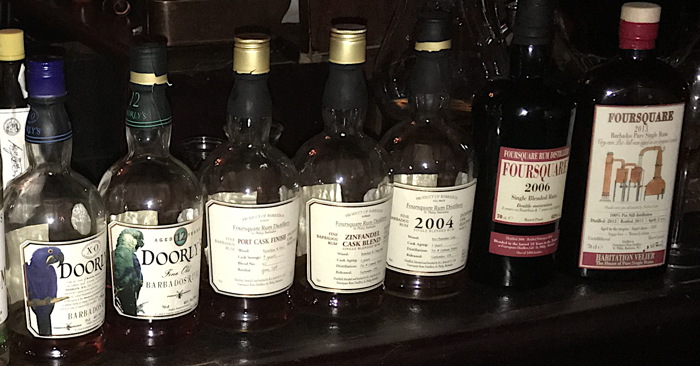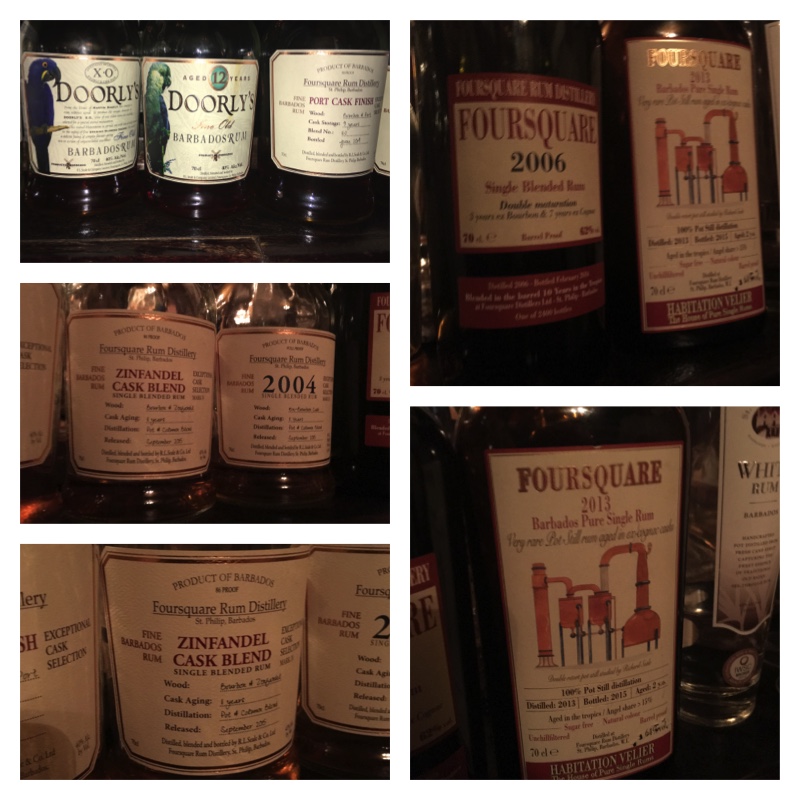This was my third rum club hosted by Peter Holland and there's always something new to learn. Held up in the Library of Liquor (Southbourne) once a month during the week, so check out the Floating Rum Shack website for further information. This night we had a guest speaker in Richard Seale from Foursquare Rum Distillery, whose laid back Bajan (meaning coming from Barbados) style was very intoxicating :-) pun intended.
On entry we were handed a Corn 'n Oil cocktail whilst we settled down. This is made from a mix of rum and Falernum over ice. I'd never heard of Falernum, which is a sweet liqueur made from rum, lime, nuts and spices.
What made this evening really interesting, aside from tasting quality rums of course, was the discussions on how the rum industry has developed from an economic and global perspective, as well as how the more artisanal rum producers are trying to educate and differentiate, learning from the lessons of the whisky industry.

It was said that modern-era rum, as in rum drunk in Europe, are brands that no one recognises in the home of rum, the Caribbean. There is a long established history of many different brands and styles of rums in the Caribbean but due to economics there has been no investment in communicating that to the wider world.
The rest of the world only knows about rum and coke, and mixing rums for cocktails. OK, a generalisation but they also mostly hold true. The rest of the world doesn't know about the artisanal rums and what has gone on in their manufacture and thus have no way to distinguish value. Some of these rums from their homelands are very unique in their own way and qualities, it's just that not many people know about it, yet.
If you look at the world of blended whisky, malt whisky, brandy and cognac for example they all follow recognised standards tat the industry has created and gravitated to. The explosion of Single Malts is only a fairly recent thing, as is the value increase. For gifts people know that if they opt for a single malt, then they are willing to pay more and have a perception of increased quality, whilst they might drink something more basic at home. In reality, you like what you like, no matter how much it is.
If we take the world of Vodka, it is mostly same base spirit, just with different packaging to change the value. OK, another generalisation, but generally true. The margins on vodka must be relatively so much greater as they don't have an ageing process and the costs associated with maturing in barrels and storage.
The 40% standard strength doesn't bring through the differences and qualities that can come through cask strength. That is the vodka strategy, chuck in snazzy bottles, packaging and advertising, and that is how you can get people to pay a lot for vodka in a skull bottle.
Phrases such as triple distillation to remove the impurities and so on have no real artisanal value, just pure marketing. Well the base product is a fermentation akin to the process of producing wine and beer. Do cognac and whisky producers remove impurities? Those are the volatile elements that contribute to the nature of the drink.
That's not to say rum producers have their own issues in their industry.
Sugar is a controversial point. Seems like the commercial producers are trying to condition consumers that more added sugar means better quality that leads onto premium pricing. It's time for something that helps people understand what it is they are buying.
Richard, in conjunction with with Luca Gargano, is trying to introduce a classification scheme to be used internationally. Not based on taste, colour, nor does it say anything about the subjective quality of quality. Just based on how it is made, to give a point of differentiation. Everything else is preference and down to individuals' tastes.
Instead of trying to recall from memory, I have pasted this in from The Floating Rum Shack website.
Pure Single Rum – 100% pot (i.e. batch) still
Single Blended Rum – a blend of only pot still and traditional column still
Rum – rum from a traditional column still
Industrial Rum – Modern multi-column still
Pot still and column still processes are very much part of the artisanal and blended processes.
The whole gold, light, dark rum classification doesn’t give any indication of the manufacturing process. By showing it is blended, single distillation, pot or still and so on, helps to distinguish and gives a label of note for personal consumption and exploration as well as for gifts.
Things like age statements can be dubious as it is more the maturation that happens. Also, years in Caribbean give more maturation than the equivalent in say Scotland, so a 5 year old rum is said to have had the same maturation as a 20 year old malt in the colder climate of Scotland. Likewise an Indian single malt whiskey of 5 years matured in the hot humid climate would be similar to a 20 year old or so. So, to compete on age with Scottish whisky is a non-starter, or at least difficult because someone will think "Oh, a 3 year old, or 5 year old that's not going to be very good is it." because they have been pre-conditioned by the whisky world.
Richard said many great things on the night, which seemed to have disappeared from my phone's notes app which is really annoying, but here are a few things I could recall.
The idea of rums for mixing is silly. If you won't drink it neat, then it's not worth putting into a cocktail.
The reason for adding caramel is to bring the colour back up to something akin to the original cask material before it got watered down.
The reason for cask strength is to give the drinker the original full taste/experience and beautiful colour. They can cut it down to the level they like. No shame in adding water to open up flavours and to reduce the strength, as with whisky.
I cheekily asked Richard if after a long journey and pitching up at a hotel does he order a rum and coke. No, was his emphatic answer. He would equally order just a rum, or rum and ginger.
We did get to drink some rum. My tasting notes have gone. Just means I have to try again, which is no bad thing.
One thing I do remember was that I found the Zinfandel finish nicer and sweeter than the Port one. And another was that the cask strength ones were strong.
There must be a reason why I photographed the Zinfandel Cask Blend and I will assume that was my favourite from the night.
Website: Rum Sixty Six